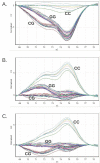Correlations between PNPLA3 Gene Polymorphisms and NAFLD in Type 2 Diabetic Patients
- PMID: 34833467
- PMCID: PMC8620174
- DOI: 10.3390/medicina57111249
Correlations between PNPLA3 Gene Polymorphisms and NAFLD in Type 2 Diabetic Patients
Abstract
Background and Objectives: Non-alcoholic fatty liver disease is a worldwide significant public health problem, particularly in patients with type 2 diabetes mellitus. Identifying possible risk factors for the disease is mandatory for a better understandingand management of this condition. Patatin-like phospholipase domain-containing protein 3 (PNPLA3) has been linked to the development and evolution of fatty liver but not to insulin resistance. The aim of this study isto evaluate the relationships between PNPLA3 and fatty liver, metabolic syndrome and subclinical atherosclerosis. Materials and Methods: The study group consisted of patients with type 2 diabetes mellitus without insulin treatment. The degree of liver fat loading was assessed by ultrasonography, and subclinical atherosclerosis was assessed using carotid intima-media thickness (CIMT). PNPLA3 rs738409 genotype determination was performed by high-resolution melting analysis that allowed three standard genotypes: CC, CG, and GG. Results: Among the 92 patients, more than 90% showed various degrees of hepatic steatosis, almost 62% presented values over the normal limit for the CIMT. The majority of the included subjects met the criteria for metabolic syndrome. Genotyping of PNPLA3 in 68 patients showed that the difference between subjects without steatosis and subjects with hepatic steatosis was due to the higher frequency of genotype GG. The CC genotype was the most common in the group we studied and was significantly more frequent in the group of subjects with severe steatosis; the GG genotype was significantly more frequent in subjects with moderate steatosis; the frequency of the CG genotype was not significantly different among the groups.When we divided the group of subjects into two groups: those with no or mild steatosis and those with moderate or severe steatosis it was shown that the frequency of the GG genotype was significantly higher in the group of subjects with moderate or severe steatosis. PNPLA3 genotypes were not associated with metabolic syndrome, subclinical atherosclerosis, or insulin resistance. Conclusions: Our results suggest that PNPLA3 does not independently influence cardiovascular risk in patients with type 2 diabetes mellitus. The hypothesis that PNPLA3 may have a cardioprotective effect requires future confirmation.
Keywords: PNPLA3; cardiovascular risk; diabetes mellitus; hepatic steatosis; insulin resistance.
Conflict of interest statement
The authors declare no conflict of interest.
Figures

Similar articles
-
The PNPLA3 rs738409 C>G variant interacts with changes in body weight over time to aggravate liver steatosis, but reduces the risk of incident type 2 diabetes.Diabetologia. 2019 Apr;62(4):644-654. doi: 10.1007/s00125-018-4805-x. Epub 2019 Jan 23. Diabetologia. 2019. PMID: 30673802
-
I148M variant of PNPLA3 increases the susceptibility to non-alcoholic fatty liver disease caused by obesity and metabolic disorders.Aliment Pharmacol Ther. 2016 Mar;43(5):631-42. doi: 10.1111/apt.13521. Epub 2016 Jan 13. Aliment Pharmacol Ther. 2016. PMID: 26765961
-
Non-alcoholic fatty liver disease and subclinical atherosclerosis: A comparison of metabolically- versus genetically-driven excess fat hepatic storage.Atherosclerosis. 2017 Feb;257:232-239. doi: 10.1016/j.atherosclerosis.2016.12.018. Epub 2016 Dec 21. Atherosclerosis. 2017. PMID: 28027788
-
Association between PNPLA3 rs738409 polymorphism and nonalcoholic fatty liver disease: a systematic review and meta-analysis.BMC Endocr Disord. 2021 Jun 19;21(1):125. doi: 10.1186/s12902-021-00789-4. BMC Endocr Disord. 2021. PMID: 34147109 Free PMC article.
-
PNPLA3 I148M and response to treatment for hepatic steatosis: A systematic review.Liver Int. 2023 May;43(5):975-988. doi: 10.1111/liv.15533. Epub 2023 Feb 16. Liver Int. 2023. PMID: 36719059
Cited by
-
Hepatic and Pancreatic Cellular Response to Early Life Nutritional Mismatch.Endocrinology. 2025 Feb 5;166(3):bqaf007. doi: 10.1210/endocr/bqaf007. Endocrinology. 2025. PMID: 39823439
-
Association of rs738409 Polymorphism in Adiponutrin Gene with Liver Steatosis and Atherosclerosis Risk Factors in Greek Children and Adolescents.Nutrients. 2022 Aug 23;14(17):3452. doi: 10.3390/nu14173452. Nutrients. 2022. PMID: 36079710 Free PMC article.
-
Identification and Evaluation of Hub Long Noncoding RNAs and mRNAs in High Fat Diet Induced Liver Steatosis.Nutrients. 2023 Feb 14;15(4):948. doi: 10.3390/nu15040948. Nutrients. 2023. PMID: 36839306 Free PMC article.
-
The Influence of Metabolic Factors in Patients with Chronic Viral Hepatitis C Who Received Oral Antiviral Treatment.Metabolites. 2023 Apr 17;13(4):571. doi: 10.3390/metabo13040571. Metabolites. 2023. PMID: 37110229 Free PMC article.
-
Global Epidemiology and Implications of PNPLA3 I148M Variant in Metabolic Dysfunction-Associated Steatotic Liver Disease: A Systematic Review and Meta-analysis.J Clin Exp Hepatol. 2025 May-Jun;15(3):102495. doi: 10.1016/j.jceh.2024.102495. Epub 2024 Dec 26. J Clin Exp Hepatol. 2025. PMID: 39882540 Review.
References
MeSH terms
Substances
LinkOut - more resources
Full Text Sources
Medical
Miscellaneous

